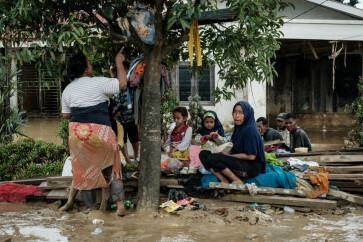Popular Reads
Top Results
Can't find what you're looking for?
View all search resultsPopular Reads
Top Results
Can't find what you're looking for?
View all search resultsSafeguarding the porous border into Timor Leste
Fun in the sun: Children play in a dry and rocky riverbed in Silawan village, East Tasifeto, Belu, East Nusa Tenggara (NTT)
Change text size
Gift Premium Articles
to Anyone
F
span class="caption" style="width: 497px;">Fun in the sun: Children play in a dry and rocky riverbed in Silawan village, East Tasifeto, Belu, East Nusa Tenggara (NTT). (JP/Yuliasri Perdani)
Entering the fifteenth year of Timor Leste's separation from Indonesia, the Indonesian authorities are still struggling to diminish illegal border crossing and smuggling due to limited resources and poor infrastructure in the border areas.
The border crossing between both nations is facilitated by six check points, including the Mota'ain main border gate that connects East Tasifeto in East Nusa Tenggara (NTT) with Balibo in Timor Leste.
The border gate is equipped with a building complex consisting of military and police security posts as well as immigration, customs and animal and plant quarantine posts.
Last year, the Atambua Immigration office recorded a total of 150,791 arrivals and departures through the six check points; more than half were through Mota'ain.
The border crossing in Mota'ain is fostered by the growth of shuttle services business connecting Kupang in NTT with Dili, the capital of Timor Leste.
In contrast with Mota'ain, five other check points face technical and infrastructure limitations that have resulted in loopholes enabling smuggling and illegal entry.
Turiskain check point in Raihat sub-district, Belu, NTT, for instance, comprises a small building, which is guarded by two immigration officers. When The Jakarta Post visited the check point over the weekend, no customs officials were on duty.
There is no security post, only a handful of soldiers and local police conducting regular patrols around the check point.
The Turiskain check point plays an important role in connecting families divided by the border. Up to 65 percent of 12,000 Raihat residents are former refugees from Timor Leste.
To reach Timor Leste, Raihat locals need to show their Pas Lintas Batas (cross-border pass) at the immigration check point before walking through a wide and rocky riverbed, which serves as the boundary-mark between the two countries.
However, the border crossing is sometimes temporarily halted between November and March, due to the rainy season. Heavy rainfall makes the crossing the river too dangerous.
However, some locals cross the river regardless and wade through the chest-high waters while battling the strong current.
'We can deal with it. But a bridge would be good,' a local, Arkadius Subesi, said.
Aside from visiting family, locals also use the cross-border path for trade.
Every Saturday, a local farmer, Domingus Aleo, passes the Turiskain check point to reach Maliana in Bobonaro, Timor Leste. He carries 5 liters of gasoline, medicine and a bag of fertilizer to be sold at Maliana Market.
Like the majority of residents in his village in Maumutin, Domingus prefers to do business at Maliana Market as it is much closer than the market in his neighborhood. Besides, Domingus claimed to earn more at Maliana Market.
'We bought premium [subsidized gasoline] here for Rp 35,000 [US$3] per five liters, we sold there for $6,'
he said.
Domingus said the police and soldiers patrolling the region had never stopped him or other residents from selling subsidized fuel in Timor Leste.
So far, the Indonesian Military (TNI) has focused on only busting major fuel smuggling operations. From January to March, the TNI tackled the smuggling of 21,024 tons of fuel, with 13,072 were subsidized gasoline.
In some cases, the smugglers use small paths and unguarded shores to transport the fuel.
Atambua Immigration head Anggiat Napitupulu said that 42 small paths across NTT were used by individuals for illegal activities.
'Many Indonesians living near the unguarded path are reluctant to pass through the authorized check points, as they are far from their homes. So, they take the shortcut instead,' Anggiat said.
Due to a limited number of staff, no officers safeguard the paths.
'The office consists of 45 officers, including me. Most of the officers are assigned to the six check points. So the best thing we can do is conduct regular patrols on the unguarded paths,' he said.
The office, he continued, only had two four-wheel drive vehicles and a motorcycle to assist in the monitoring of the 148.7 kilometers of check points and unguarded paths.

.img_assist_custom-500x373.jpg)








